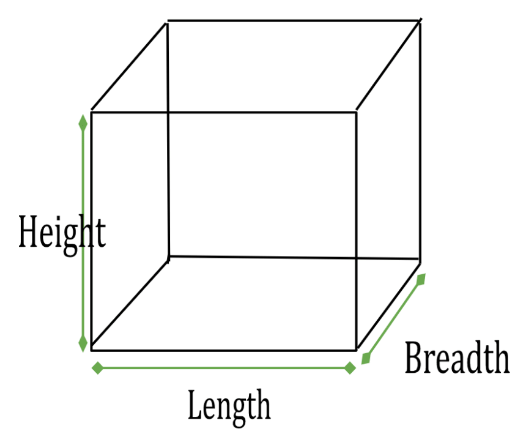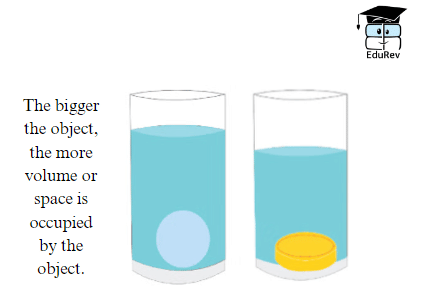How Big? How Heavy? Class 5 Notes Maths Chapter 14

When we talk about something being "big," we mean how much space it takes up, like if it's tall or wide. When we say something is "heavy," we mean it weighs a lot, like if it's hard to lift. You can figure out both by finding out how much room something takes up, which we call its volume.
Measurements
- Kilograms are commonly used to measure the weight of objects.
- Grams (g) and Milligrams (mg) are used to measure the weight of smaller objects (mg).
- Length is measured in centimeters (cm), millimeters (mm), and Meter (m).
- One milliliter of water has a volume of 1 cubic centimeter.

Coin and Marble
- If the weight of two objects is the same, the size and shape of those two quantities do not have to be the same.
- If we take one ₹5 coin and one marble, both of them weigh the same, but when each of them is placed in a glass with equal amounts of water. Water will slightly rise in a marble containing water compared to a water-containing coin.
- This is because a marble (which is spherical) has a larger volume than a coin (which is flat), even if it weighs the same.

Volume
- The capacity of an object is measured by its volume.
- The volume is measured in cubic units such as m3, cm3, and so on.
- For example, a cup's volume is 100 ml if it can carry 100 ml of water up to the top.
Roughly Comparing the Volumes
- We can roughly compare the volume of one tennis ball to that of five (or more) marble balls.
- This can be calculated by filling two containers with equal amounts of water, placing a tennis ball in one container, and continuing to add marbles to the water in another container until the water level in both containers rises to the same level.
 Comparing the Volume of a Tennis Ball and Marbles
Comparing the Volume of a Tennis Ball and Marbles
Length, Width, and Height
- The longest dimension of a figure is length, which indicates how long the object is.
- Width is the shorter distance between two points that indicates how broad or wide an object is.
- The height of an object defines how long or deep it is.

Example: Find the length, width, height, and volume of the matchbox.
Take a matchbox and a measuring scale.
Measure the length, width and height of the matchbox.
Then calculate its volume = length x width x height
Here, The length of the matchbox is 5cm long, Its width is 3cm wide and its height is 1cm.
So Its volume = 5 ×3 × 1 = 15cm3
Volume of Cuboid
- A cuboid is a solid geometrical object with 6 faces.
- The number of cubes that can be packed into a cuboidal box is equal to the volume of the cuboidal box.
- Volume of cuboid(V) = length × breadth × height
- Volume of cuboid (V)= l × b × h
 Cuboid
Cuboid
Example 1: Find the number of cubes that can be packed into the cuboidal box with length = 10 cm, breadth=6 cm and height = 20 cm.
Sol: Length = 10 cm, Breadth = 6 cm and Height = 20 cm.
Number of cubes packed = Volume of cuboidal box = length x width x height
Number of cubes packed = Volume = 10 x 6 x 20
So, 1200 cubes can be packed.
Example 2: Find the volume of a cuboid whose length = 5 cm, width = 2 cm and height = 3 cm.
Sol: Given, length = 5 cm, width = 2 cm and height = 3 cm
By the formula, we know;
Volume of cuboid = length x width x height
= 5 cm x 2 cm x 3 cm
= 30 cm3.
Example 3: Calculate the amount of air that can be accumulated in a room that has a length of 5 m, a breadth of 6 m, and a height of 10 m.
Sol: Amount of air that can be accumulated in a room = capacity of the room = volume of a cuboid
The volume of cuboid = l × b × h = 5 ×6 ×10 = 300 m3
Thus, this room can accommodate a maximum of 300 m3 of air.
Volume of Cube
- A cube is a solid geometrical object with 6 faces.
- All the sides of the cube are equal in length.
- Volume of a cube(V) = length × breadth × height
- Volume of a cube(V) = s x s x s (where s is the side of the cube)
- Volume of a cube(V) = s3
 Volume of Cube
Volume of Cube
Example 1: Find the volume of the cubical box with length=11 cm, breadth= 11 cm and height =11 cm.
Sol: Length=11 cm, Breadth=11 cm and Height =11 cm.
Volume = length x width x height
Volume = s x s x s
Volume = 11 x 11 x 11
Volume = 1331 cm3
Example 2: What is the volume of a cube of side 15 cm?
Sol: Given,
Side of the cube = a = 15 cm
The volume of a Cube V = a3
V = 153 cm3
∴ V = 3375 cm3
Example 3: If the volume of a cube is 216 cm3, then what is the measure of the edge of a cube?
Solution:Given, Volume of a cube = V = 216 cm3
We know that, V = (side)3 or (edge)3
(edge)3 = 216 = 63
Therefore, edge of the cube = 6 cm

Counting Coins
- To calculate the weight of the sack, we need to multiply the weight of the sack by 1000. And, to calculate the number of coins, we need to divide the total weight of the sack by the weight of each coin.
- Total weight of sack = Weigh of sack × 1000 as (1kg =1000g).
- Number of coins = Total Weight of sack ÷ Weight of each coin.
Example 1: The weight of a 5 rupee coin is 9 g. How many coins are there in a sack of 5 rupee coins if it weighs 27 Kg?
Sol: The weight of a 5 rupee coin is 9 g, and the weight of a sack is 27Kg.
We know that 1Kg =1000g.
Step1: Find the total weight of sack = Weigh of sack × 1000 = 27 × 1000 = 2700.
Step2: Write the weight of each coin = 9 g
Step3: Number of coins = Total Weight of sack ÷
Weight of each coin= 2700 ÷ 9 = 300
So, the number of coins is 300.
Example 2: A 2 rupee coin weight 5 g. What is the weight of a sack with 2000 coins?
Sol: Step1: Write the weight of each coin = 5 g
Step2: Write the total number of coins = 2000
Step3: Find the total weight of sack = Total number of coins × weight of each coin = 2000 × 5 g = 10,000 g.
So, the total weight of the sack is 10,000 g.
|
28 videos|169 docs|41 tests
|
FAQs on How Big? How Heavy? Class 5 Notes Maths Chapter 14
| 1. What is the difference between volume and weight? |  |
| 2. How can I measure the volume of a coin or a marble? |  |
| 3. Why is it important to understand the volume of objects like coins and marbles? |  |
| 4. Can different shapes of the same volume have different weights? |  |
| 5. How does temperature affect the volume of materials like coins and marbles? |  |

|
Explore Courses for Class 5 exam
|

|





















